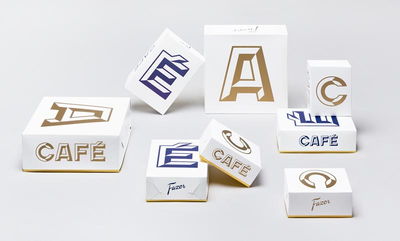What are the factors that affect packaging? How to choose the packaging of coffee and what are the types of packaging?
When the baking is finished, the coffee will be ready to use. It is important to pack it as soon as possible to avoid the loss of aroma and keep it fresh. After contact with the air, the water and oxygen in the air accelerate the oxidation process, making the quality of coffee worse.

Factors affecting packaging
Packaging is an important and careful process that protects coffee from the following factors:
1. Environment: when you come into contact with air, coffee will deteriorate-- more serious for coffee powder. Because of exposure to air, coffee powder reacts with a larger surface area.
2. Oxygen: because it oxidizes the aroma components, especially the fat, and produces a rotten flavor (halafness).
Temperature: fresh grinding will quickly absorb moisture in the air, increase weight and reduce the effectiveness of extracting coffee ingredients, and internal molecular pressure makes things more complicated. During the roasting process, carbon dioxide is produced in the coffee beans, and carbon dioxide also reduces some aroma.
The purpose of selecting the type of packaging
It is the most important thing for coffee producers to ensure that the aroma of coffee does not change before use. To solve this problem, they and packaging equipment manufacturers continue to design new equipment to meet different needs. Although the most perfect method does not exist, the manufacturer must choose one of several methods to get the best results. The choice of packaging method depends on the type of consumer (bar, restaurant, family), transportation distance and mode of supply.
1. Prevent coffee from coming into contact with air, oxygen and water in the process of preserving coffee, so as to avoid the loss of aroma.
2. Packaging materials should have strength to prevent accidental tearing or damage by external pressure.
3. Easy to open
4. After opening, it can prevent the influence of air and humidity.
The manufacturer should consider the size of the package according to the type of user and the variety of coffee. For example, household coffee powder should be packed in small packages so that it can be used up as soon as possible. The two commonly used types of packaging are small bags and listening to packaging. Small bags are more widely packaged because of their small footprint, low cost and easy vacuum packing. But the material is soft, easy to damage, and can not withstand excessive pressure, once opened, it is difficult to re-seal. Listening to packaging is rare, more expensive, takes up more space, but is more resistant to external pressure. If there is a plastic cover, it can be sealed again, so it is safer.
Packing type
1. Flexible non-airtight packaging
This is the most economical one. It is usually used by local small baking plants because they can guarantee prompt supply. Coffee beans can be consumed in time. Coffee beans packaged in this way can only be preserved for a short time.
2. Airtight packaging
Suitable for bar, household or indirect supply (supermarket, etc.). Small bags and tins are fine. after filling the coffee, vacuum and seal the coffee. Due to the formation of carbon dioxide in the roasting process, this packaging can only be packaged after the coffee has been degassed for a period of time, so there is a storage interval of several days. Coffee beans last longer than powdered coffee. Because the storage period does not need to be separated from the air, so the cost is low. The coffee in this packing should be used up within 10 weeks.
3. Packaging of one-way valve
Both pouches and tins can be used. After baking, the coffee is put into a special vacuum container with an one-way valve. This valve allows gas to go out, but not in. There is no need for separate storage stage, but due to the outgassing process, the aroma will be lost a little. It avoids the formation of the smell of corruption, but can not stop the loss of aroma.
4. Pressure packing
This is the most expensive way, but it can preserve coffee for up to two years. The size depends on the type of user: home or bar. After roasting for a few minutes, the coffee can be packed in a vacuum. After adding some inert gas, keep the appropriate pressure in the package. The coffee beans are preserved under pressure, leaving the aroma on the fat, thus improving the aroma of the beverage.
Important Notice :
前街咖啡 FrontStreet Coffee has moved to new addredd:
FrontStreet Coffee Address: 315,Donghua East Road,GuangZhou
Tel:020 38364473
- Prev

Five tips for making delicious coffee and how to improve the probability of making a cup of delicious coffee
Coffee quality: to comment on the quality of a cup of coffee, you should have an in-depth understanding of the basic information of coffee, such as the variety of coffee, the place of production and regional characteristics of coffee beans, the height of planting, the process of handling raw beans, bean age, purity, size and water content. However, such detailed information is usually not available, so taste and aroma become the final criteria, and experience becomes the conclusion of coffee.
- Next

Boutique coffee: Jamaica Blue Mountain Coffee, Cuban Crystal Mountain Coffee, Hawaii Kona Coffee
Jamaica Blue Mountain Coffee (Jamaican Blue Mountain) I believe I have not introduced everyone has heard of the name of Blue Mountain Coffee, Jamaica Blue Mountain Coffee is the best coffee in the world, it is called black jewel. Like Rolls-Royce cars and Stradivari violins, when something gains the best reputation in the world, that reputation often forms it.
Related
- Beginners will see the "Coffee pull flower" guide!
- What is the difference between ice blog purified milk and ordinary milk coffee?
- Why is the Philippines the largest producer of crops in Liberia?
- For coffee extraction, should the fine powder be retained?
- How does extracted espresso fill pressed powder? How much strength does it take to press the powder?
- How to make jasmine cold extract coffee? Is the jasmine + latte good?
- Will this little toy really make the coffee taste better? How does Lily Drip affect coffee extraction?
- Will the action of slapping the filter cup also affect coffee extraction?
- What's the difference between powder-to-water ratio and powder-to-liquid ratio?
- What is the Ethiopian local species? What does it have to do with Heirloom native species?

